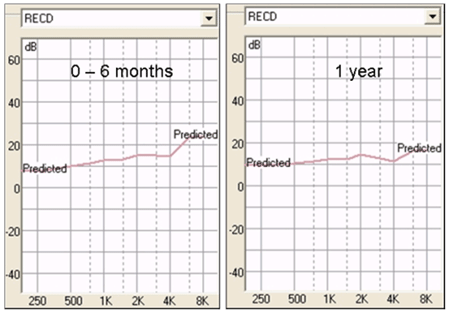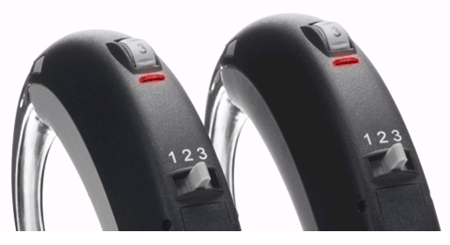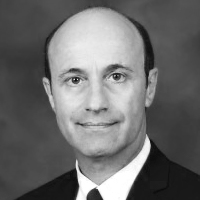Introduction
Hearing loss in children is the most common "birth defect" in the USA. ASHA (2005) reported prevalence of newborns with congenital hearing loss ranged from 1 to 6 children per thousand. NIDCD (2003) reported 12,000 babies born annually in the USA with hearing loss. Niskar, Kieszak et. al. (1998) estimated 15 percent of children between ages 6 and 19 years have hearing loss in one or both ears and approximately 1/3rd of all children with hearing loss have additional impairments (Tharpe, Fino-Szumski & Bess, 2001). Cytomegalovirus (CMV) is the most common congenital infection among newborns in the USA (Nieves, 2005). Some 15-20 percent of asymptomatic CMV infected infants will develop hearing loss or deafness which was not detectable at birth (Schleiss, 2005).
Although professionals previously thought the "developmental window of opportunity" for audition, speech and language was open until ages two to three years, it is now known that the earliest possible identification and treatment of hearing loss leads to the most advantageous outcomes. Newman (2005) confirmed infants perform sophisticated auditory processing in noisy backgrounds at age 5 months. Houston (2002) noted during the first 6 months of life, normal hearing children detect and discriminate fine differences in speech, facilitating "language specific" speech perception skills after 6 months. Flexer (2005) noted that if the child cannot hear spoken instruction, the entire premise of the educational system is undermined. Yoshinaga-Itano, et. al., (1998) compared expressive and receptive language abilities of hard-of-hearing children. Children identified before age 6 months demonstrated significantly better language scores, than later-identified children.
Adults & Children: Similar but Different
Children are not simply "small adults." Although outcomes data regarding hearing aid fittings for pediatrics is enormously desirable, collecting audiometric data from younger children is not always possible. Additionally, threshold-based fitting rationales assume amplification needs are more or less universal and can be based on audiometric configuration. Unfortunately, this is not true in adults, and perhaps less true in children.
In this article, we'll explore similarities and differences between children and adults with respect to hearing, amplification and related topics, and we'll offer our perspectives on advanced technology solutions, as applied to pediatric hearing loss.
Etiology of Hearing Loss
Most adults exhibit gradual onset sensorineural hearing loss (SNHL) typically attributable to noise exposure or aging in a noisy world. Children with SNHL generally have different etiologies; congenital malformations, pre-natal or peri-natal infections, syndromes, a multitude of diseases, and likely bouts of temporary conductive hearing loss (CHL) as an "overlay" to SNHL, and other causes, too.
When fitting hearing aid amplification for children, the clinician must select flexible and durable technology, while understanding adjustments and changes will be needed. The audiologist must recognize the limits of standard fitting rationales and be prepared to make adjustments for the individual (adult and child) based on their specific needs.
Anatomic & Physiologic Issues
Significant anatomic differences between very young children and adults exist. Variations in ear and head, shape and size facilitate different responses of hearing aids in-situ, with respect to adults and children. A plethora of literature describes these differences and provides clinical guidance and direction regarding modification of hearing aid fittings (i.e., RECD) to account for the specific acoustic needs of children (see Figure 1).
However, acoustic verification alone cannot assure benefit from amplification. Winter & Eisenberg (1999) noted real ear measures reflect hearing aid performance, not the listener's response. Eisenberg (2000) cautioned that verification of audibility does not assure appropriate intelligibility with respect to pediatric fittings for severe to profound hearing loss.
Figure 1. Predicted RECD for two age ranges of infants.
The advantages of normal hearing goes beyond speech, language and auditory skills. Peripheral and central nervous systems are impacted by auditory sensation. Henderson et. al. (1994) determined loss of cochlear hair cells significantly alters neural codes from the cochlea to the brain. Diamond (1996) reported nerve cells within Wernicke's area have increased dendrite counts in college educated people, as compared to those with only a high school education, and, environmental input (i.e., acoustic stimulation) increases cortical growth in children.
Purpose of Amplification
Many children acquire hearing loss prior to maturation of their speech and language skills. Therefore, the "purpose" of amplification for children is different than the purpose of amplification for a typical SNHL adult.
For adults, hearing aid amplification supplements remaining auditory capabilities. The hearing aid's purpose is to replace/supplement auditory information in tandem with the adult's stored linguistic knowledge. Adults can "fill in the blanks" using acquired linguistic knowledge.
Conversely, when fitting hearing impaired children an "immersion approach" is typically assumed. The hearing aid's "purpose" is to provide as much auditory input as possible as the child does not possess acquired linguistic knowledge from which he/she can "fill in the blanks." Importantly, the goal of pediatric hearing aid fittings should not be limited to maximizing audibility. Rather, the goal should be to maximize the "perception of speech" (Flynn & Schmidtke, 2002).
The difference between adult supplementation and pediatric immersion has important implications with respect to the hearing aid fitting rationale chosen, adjustments made, and the advanced signal processing chosen.
Physical Design Considerations
For adults, multiple hearing aid styles (CIC, ITC, ITE, BTE) offer choices regarding; cosmetics, low visibility, easy insertion, manipulation of controls and other factors.
For children, different priorities prevail. Amplification should provide reliability, individualized and adaptable electro-acoustic parameters, a secure and seamless integration of accessories such as FM (Schmidtke-Flynn & Flynn, 2004), tamper-resistance, durability, battery security, appealing appearance, easy management and maintenance by a caregiver, and more.
Figure 2 demonstrates two features designed specifically for pediatric use on the Oticon Sumo; the volume control wheel (VCW) and the alerting LED.
Figure 2. Oticon Sumo volume control wheel and alerting LED.
Multi-channel, Non-Linear Amplification
The primary goal of multi-channel, nonlinear amplification (MCNL) is to achieve maximal audibility for the SNHL patient, within their limited dynamic range. DSL i/o (Seewald, 1997) is a popular fitting rationale for pediatric amplification. DSL i/o aims to amplify speech sounds to make the vast range of auditory inputs audible and comfortable without distortion and to restore loudness perception. Most non-linear fitting rationales (such as NAL-NL1 and proprietary manufacturer's rationales) offer access to this broad range of input and accomplish similar goals.
Non-linear amplification used with children has been shown to enhance speech recognition in quiet and noise for loud and soft sounds (Eisenberg, 2000). Regarding children with severe hearing loss, Flynn, Davis and Pogash (2004) reported on 21 children and found a highly significant benefit for children using non-linear amplification with respect to language and educational outcomes. Pogash and Flynn (2003) evaluated 15 children with profound hearing loss and determined MCNL amplification provided significant improvement regarding audibility, listening preference and perhaps most importantly, for speech understanding in quiet and noisy backgrounds.
Background Noise
Protecting the primary speech signal while minimizing background noise and maximizing the speech-to-noise ratio is of paramount importance. Achievement of these goals can be facilitated three ways; FM Systems, Directional Microphones and Noise Management Circuits.
A- FM Systems
Boothroyd (2005) stated of all protocols available to deliver sound (hearing aids, cochlear implants, sound field, etc) the personal FM system is most effective. Flexer (2005A) emphasized that many children wearing hearing aids need the "superior signal-to-noise ratio" provided by personal FM systems. FM is well established as a vitally important component of pediatric aural rehabilitation. Laugesen & Schmidtke (2004) addressed the multiple advantages provided by FM systems in noisy environments and emphasized the need for clear, audible and consistent signals for children during communication events.
B- Directional Hearing Aids
While directional hearing aid acceptance in the adult population has grown significantly, pediatric use of directional technology appears unresolved. Although "face-to-face" scenarios represent typical adult communication interactions, children are often in play-based, group communication situations in which primary speech signals and noise originate from multiple locations - often simultaneously!
The most important aspect of any directional system is the underlying decision making. In Oticon's Syncro and Tego products, decisions regarding directionality are implemented based on Artificial Intelligence (AI). Artificial Intelligence determines whether the SNR would be improved by shifting to a directional mode based on the outcome of the signal processing, not the input. In the Split Directional mode, low frequencies (below 1000 Hz) are kept in omni to maintain loudness and sound quality, while high frequencies (above 1000 Hz.) employ adaptive directionality at lower loudness levels. When an improved SNR is determined, the system shifts into directional mode.
AI technology assures the child, parents and teachers that directionality is only enabled when it will provide real-world benefits, by attenuating multiple sources of noise while allowing multiple speech signals.
C- Noise Management Systems
Some modulation-based noise reduction systems may inadvertently reduce speech sounds when speech and noise share spectral components or when the signal-to-noise ratio is particularly challenging -- if the speech signal is not protected, or given priority. Although this is less of an issue for adults capable of "filling-in-the-blanks" this concern previously had to be carefully considered regarding pediatric fittings.
Oticon's TriState Noise Reduction system protects the speech signal while noise reduction is applied to loud, non-essential low and extremely high frequency sounds when speech is present. Likewise, noise attenuation occurs across the bandwidth when speech is not present. Parallel processing and artificial intelligence allow channel-specific noise reduction strategies to be implemented for speech in quiet, speech in noise, and for noise-only situations.
Feedback Control and Open Fittings
Modern digital hearing aids incorporate adaptive feedback cancellation systems which do not compromise audibility or sound quality. Given the smaller-sized external ear canals of children, the continued physical growth throughout adolescence and the likelihood of greater physical movement, feedback cancellation appears to be highly beneficial and offers no negative results. Regarding adults and adaptive feedback cancellation systems, the additional benefits of open-ear fittings (less occlusion effects and better sound quality) are more obtainable while using adaptive feedback cancellation systems.
Summary Statements:
Therefore, based on the above assumptions and provisions, when fitting amplification to children with SNHL, the following points should be considered:
- All children* with SNHL should be considered candidates for MCNL amplification. The amplification goal is to provide access to the broadest range of inputs possible. Children with severe to profound SNHL should be considered candidates for MCNL amplification as long as the fitting rationale is "corrected" for their degree of loss.
* Only children with classic "corner audiograms" are initially considered linear candidates.
- Hearing aids should allow simple and stable connection to a compatible FM system.
- Directionality should be considered for all children. The minimum age at which this feature is activated and the choice between automatic versus manual control should be left to the discretion of the audiologist working in tandem with the parents and others, based on the individual needs and circumstance of the patient.
- Noise Reduction to protect and maintain speech sounds in noise should be considered. The choice to activate this feature should be left to the audiologist working in tandem with the parents and others, based on the individual needs and circumstance of the patient.
- Adaptive feedback cancellation should be included to reduce/eliminate feedback in pediatric fittings and to enhance open ear fittings for adults.
- Hearing aids should be fit using software that allows easy, sensible management of the physical differences between adult and pediatric ears.
- Hearing aids should offer pediatric-friendly physical design features, for the child and the caregiver, such as; the ability to lock or disable switches (i.e., the volume control wheel), durable construction, preferred setting indicators, etc.
Please Note: An earlier version of this article was provided by Oticon to audiology graduate students as a special supplement to the Hearing Journal, December, 2005.
Works Cited
ASHA (2005). The Prevalence and Incidence of Hearing Loss in Children. Retrieved on November 11, 2005, from www.asha.org/public/hearing/disorders/children.htm
Boothroyd, A. (2005). Modeling the effects of Room Acoustics on Speech Reception and Perception. In C.C. Crandell, J.J. Smaldino and C. Flexer (Eds.), Sound Field Amplification: Applications to Spech perception and Classroom Acoustics (2nd ed., pp. 23-48). New York: Thomson Delmar Learning.
Diamond, M.C. (1996). The Brain...Use it or Lose it. Mindshift Connection, 1(1). Retrieved November 14, 2005, from www.newhorizons.org/neuro/diamond_use.htm
Eisenberg, L.S. (2000). Update on Hearing Aid Fitting in Children. Current Opinion in Otolaryngology & Head and Neck Surgery. 8(5), 409-414
Flexer, C. (2005). Rationale for the Use of Sound Field Systems in Classrooms: The Basics of Teacher In-Services. In C.C. Crandell, J.J. Smaldino and C. Flexer (Eds.), Sound Field Amplification: Applications to Spech perception and Classroom Acoustics (2nd ed., pp. 3-22). New York: Thomson Delmar Learning.
Flexer C. (2005A). Laws and Regulations That Govern the Utilization of Sound Field Amplification. In C.C. Crandell, J.J. Smaldino and C. Flexer (Eds.), Sound Field Amplification: Applications to Spech perception and Classroom Acoustics (2nd ed., pp. 235-247). New York: Thomson Delmar Learning.
Flynn, M.C., Davis, P.B., & Pogash, R. (2004). Multiple Channel Non-Linear Power Hearing Instruments for Children with Severe Hearing Impairment: Long Term Follow-Up. International Journal of Audiology, 43(8), 479-485.
Flynn, M.C. & Schmidtke, T.E. (2002). Four Fitting Issues for Severe or Profound Hearing Impairment. The Hearing Review, 9(11), 28-33.
Henderson, D., Salvi, R.J., Boettcher, F.A. & Clock, A.E. (1994). Neurophsiologic Correlates of Sensory-Neural Hearing Loss. In J. Katz (Ed.), Handbook of Clinical Audiology, (4th ed., pp. 37-55). New York: Williams & Wilkins.
Houston, D.M. (2002). What infants learn about native language sound organization during their first year, and what may happen if they don't. In K. Schauwers, P. Govaerts, & S. Gillis (Eds.) Antwerp Papers in Linguistics 102: Language Acquisition in Young Children with a Cochlear Implant. (pp. 11-21). University of Antwerp, Antwerp, Belgium. Retrieved on November 14, 2005, from webhost.ua.ac.be/apil/apil102/apil102.pdf
Laugesen, S. & Schmidtke, T. (2004, January). Improving on the Speech-in-Noise Problem with Wireless Array technology. Audiological Research Documentation: News From Oticon. Retrieved on November 14, 2005, from www.tego.oticon.ca/eprise/main/Oticon/com/SEC_Professionals/
ProductInformation/FMSolutions/Lexis/91007910nfo_lexis.pdf
Newman, R.S. (2005). The Cocktail Party Effect in Infants Revisited: Listening to One's Name in Noise. Dev Psychology, 41(2), 352-362.
NIDCD (2003). National Institute for Deafness and Communication Disorders (NIDCD), NIH Publication 04-5490. Retrieved on November 14, 2005, from www.nidcd.nih.gov/health/hearing/professionals.asp
Nieves, M.R. (2005). Congenital Cytomegalovirus Infection and Disease. The Pediatric Bulletin. Retrieved November 14, 2005, from home.coqui.net/myrna/cmv.htm
Niskar A.S., Kieszak S.M., Holmes A., Esteban E., Rubin C. & Brody D.J. (1998) Prevalence of hearing loss among children 6-19 years of age: The Third National Health and Nutrition Examination Survey, 279(14), 1071-5.
Pogash, R., & Flynn, M. (2003, March 31). SuperPower for Kids. AudiologyOnline. Retrieved on November 14, 2005, from www.audiologyonline.com/articles/arc_disp.asp?article_id=420
Schleiss, M. (2005, February 18). Cytomegalovirus Infection Updated. emedicine, Retrieved on November 14, 2005, from www.emedicine.com/ped/topic544.htm
Schmidtke-Flynn, T. & Flynn, M. (2004). Designing Hearing Aids for Children with Severe-to-Profound Losses. The Hearing Review, 11(13), 36-40.
Seewald, R.C., Cornelisse, L.E., Ramji, K.V., et.al. (1997). DSL v4.1 for Windows: A Software Implementation of the Desired Sensation Level (DSL[i/o]) Method for Fitting Linear Gain and Wide Dynamic Range Compression Hearing Instruments. London, Ontario. Hearing Healthcare Research Unit, University of Western Ontario.
Tharpe, A.M., Fino-Szumski, M.S. & Bess, F.H. (2001). Survey of Hearing Aid Fitting Practices for Children with Multiple Impairments. AJA, 10(1), 32-40.
Winter, M. & Eisenberg, L. (1999). Amplification for Infants: Selection and Verification. Otolaryngologic Clinics of North America, 32(6), 1051-1065.
Yoshinaga-Itano, C., Sedey, A.L., Coulter, D.K., and Mehl, A. L.: Language of Early and Later Identified Children with Hearing Loss. Pediatrics, 102(5), 1161-1171.
Recommended Reading
American Academy of Audiology (AAA) "Pediatric Amplification Protocol"
October, 2003. www.audiology.org/professional/positions/pedamp.pdf
Davis, P.B., & Pogash, R. (2002). Power for Kids. The Hearing Review, 9(3), 52-57.



